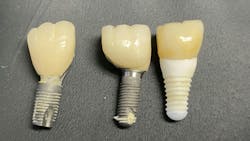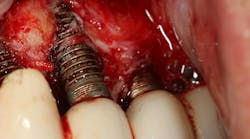Dental implant metallosis prevention and treatment
What is metallosis?
Metallosis is the medical condition involving deposition and buildup of metal debris in the soft and hard tissues of the body. Metallosis has been known to occur when metallic components in medical and dental implants, specifically joint replacements and dental implants, abrade against one another, get exposed to an acidic environment, or break down due to a bacterial challenge. Dental implant metallosis, caused by the titanium oxide layer breakdown, can contribute to dental implant failure when released titanium particles/ions into surrounding tissues cause inflammatory foreign body reactions. This process is triggered by oral bacteria and can be exacerbated by mechanical forces.
Signs of dental implant metallosis1
- Dental implant failure
- Sensitivity around the implant
- Inflammation, bleeding, pain, suppuration
- Soft and hard tissue loss proximal to the dental implant
- Numbness
Prevention and treatment of dental implant metallosis
Here are five methods for prevention and treatment of dental implant metallosis:
No. 1. Enhancing dental implant surface treatment and coatings
Studies have shown that surface modifications to dental implants, such as electropolishing and magnetoelectropolishing (two of many), can increase resistance to corrosion by changing the chemistry of implant interaction and the titanium oxide layer.2 Thermo-mechanical alterations of the dental implant surface have also shown superiority to corrosion resistance when compared with conventional surfaces. Finally, commercially pure titanium has demonstrated better resistance to corrosion than titanium alloys that contain aluminum and vanadium, since these metals corrode more easily.3
No. 2. Blood testing
Many studies in the orthopedic literature have shown the efficacy of blood testing for patients with suspected metallosis due to failing joint replacements.4 There is a lack of literature for dental implants and blood testing for metallosis. Some small studies have shown that patients receiving dental implants do not demonstrate an increased level of circulating titanium and aluminum ions.5 Other studies have shown a slight but insignificant increase in these metal ions post dental implant placement.6 If a dental implant patient is suspected of having metal hypersensitivity or sensitivity to the breakdown products of titanium, companies such as Orthopedic Analysis and Vibrant Wellness offer a metal hypersensitivity blood test.
No. 3. Laser decontamination of affected sites
Titanium implant breakdown/particle release into the proximal area of the failing implant has been shown to lead to soft- and hard-tissue breakdown.7 One study showed laser decontamination of the proximal hard and soft tissue increased the success of peri-implant regenerative therapy around the failing dental implant. The idea was that the ablation of the titanium particles/ions from the tissue led to a reduced inflammatory response and an increase in the regenerative treatment.8
No. 4. Implant removal
Peri-implant bone loss and failure due to foreign body response from titanium particle release may need to be treated by removal of the inflammatory source or removal of the dental implant itself.9 Studies have shown that dental implant replacement after a previous failure enjoys high success rates.10
No. 5. Nonmetallic dental implants?
Many studies have suggested that one method of preventing metallosis is to use pure ceramic implants. In vitro studies have shown that certain zirconia alloys have an increased resistance to corrosion and the potential for metallosis when compared with conventional titanium surfaces.11 However, according to one systematic review, any material placed in the living body will be recognized by the immune system and can induce an immune response. Despite their high biocompatibility, ceramic implants can cause a variety of local and systemic immune responses, which may be easily detectable by overt clinical symptoms or may proceed as low-grade, latent inflammation.12 All types of ceramic implants can potentially cause an inflammatory response in the body. At the present time, more controlled studies are needed to investigate the breakdown potential of ceramic implants.
Conclusion
Complete prevention of metallosis caused by orthopedic implant and dental implant breakdown has not been described in the literature as of today. Many prevention strategies include implant surface alterations and treatments that make the implant more resistant to breakdown and corrosion. Ceramic implants have been suggested as a viable option for those concerned with metal breakdown. If an implant is suspected to be causing a systemic/local reaction due to breakdown, it can be treated with laser debridement or removal. Testing for metallosis via blood tests has been reported in case studies, but more controlled trials are needed.
Editor’s note: This article originally appeared in Perio-Implant Advisory, a chairside resource for dentists and hygienists that focuses on periodontal- and implant-related issues. Read more articles and subscribe to the newsletter.
References
- Olmedo D, Tasat D, Duffó G, Cabrini R, Guglielmotti M. Systemic and local tissue response to titanium corrosion. In: Bensalah N, ed. Pitting Corrosion. IntechOpen; 2012. doi:10.5772/32500
- Rahman ZU, Pompa L, Haider W. Influence of electropolishing and magnetoelectropolishing on corrosion and biocompatibility of titanium implants. J Mater Eng Perform. 2014;23:3907-3915. doi:1007/s11665-014-1205-3
- Souza JC, Barbosa SL, Ariza EA, et al. How do titanium and Ti6Al4V corrode in fluoridated medium as found in the oral cavity? An in vitro study. Mater Sci Eng C Mater Biol Appl. 2015;47:384-393. doi:10.1016/j.msec.2014.11.055
- Sampson B, Hart A. Clinical usefulness of blood metal measurements to assess the failure of metal-on-metal hip implants. Ann Clin Biochem. 2012;49(Pt 2):118-131. doi:10.1258/acb.2011.011141
- Sharma V, Agrawal S, Sharma D, Thorat R, Srichand R, Dalave P. Assessment of metal ions levels in blood of dental implant patients. J Pharm Bioallied Sci. 2023;15(Suppl 2):S913-S915. doi:10.4103/jpbs.jpbs_47_23
- Gopi G, Shanmugasundaram S, Krishnakumar Raja VB, Afradh KM. Evaluation of serum metal ion levels in dental implant patients: a prospective study. Ann Maxillofac Surg. 2021;11(2):p 261-265. doi:10.4103/ams.ams_70_21
- Fretwurst T, Nelson K, Tarnow DP, Wang HL, Giannobile WV. Is metal particle release associated with peri-implant bone destruction? An emerging concept. J Dent Res. 2018;97(3):259- doi:10.1177/0022034517740560
- Rosen PS, Froum SH, Froum SJ. A rationale for postsurgical laser use to effectively treat dental implants affected by peri-implantitis: two case reports. Int J Periodontics Restorative Dent. 2020;40(4):561-568. doi:10.11607/prd.4428
- Wilson Jr TG. Bone loss around implants—is it metallosis? J Periodontol.2021;92(2):181-185. doi:10.1002/JPER.20-0208
- Park YS, Lee BA, Choi SH, Kim YT. Evaluation of failed implants and reimplantation at sites of previous dental implant failure: survival rates and risk factors. J Periodontal Implant Sci. 2022;52(3):230-241. doi:10.5051/jpis.2105020251
- Vasilescu E, Drob P, Raducanu D, et al. In vitro biocompatibility and corrosion resistance of a new implant titanium base alloy. J Mater Sci Mater Med. 2010;21(6):1959-1968. doi:10.1007/s10856-010-4057-x
- Rafikova G, Piatnitskaia S, Shapovalova E, et al. Interaction of ceramic implant materials with immune system. Int J Mol Sci. 2023;24(4):4200. doi:10.3390/ijms24044200
About the Author

Scott Froum, DDS
Editorial Director
Scott Froum, DDS, a graduate of the State University of New York, Stony Brook School of Dental Medicine, is a periodontist in private practice at 1110 2nd Avenue, Suite 305, New York City, New York. He is the editorial director of Perio-Implant Advisory and serves on the editorial advisory board of Dental Economics. Dr. Froum, a diplomate of both the American Academy of Periodontology and the American Academy of Osseointegration, is a volunteer professor in the postgraduate periodontal program at SUNY Stony Brook School of Dental Medicine. He is a PhD candidate in the field of functional and integrative nutrition. Contact him through his website at drscottfroum.com or (212) 751-8530.

